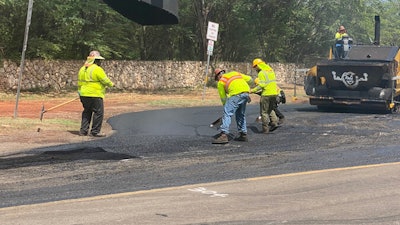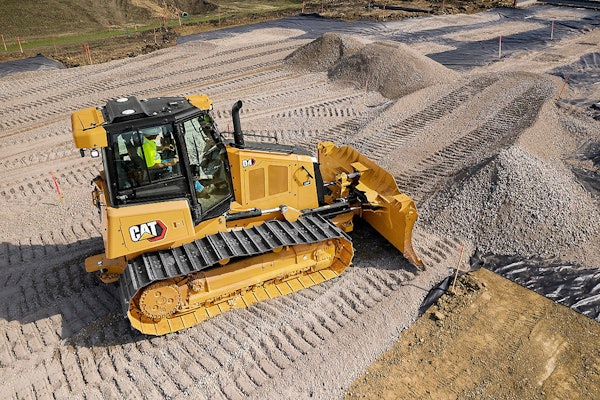
In areas as diverse as Oahu and Staten Island, departments of transportation are paving roads with asphalt mixed with recycled plastic.
On October 28, two public roads on Staten Island became the first in New York to be paved with an asphalt mix, which used 214,534 plastic bottles. The project was a collaboration between the New York City Department of Transportation and MacRebur, a British waste-plastic road company.
On October 11, paving began that will use 195,000 plastic bottles to apply 1,950 tons of modified asphalt on a road in Oahu, Hawaii. The Hawaii Department of Transportation is using the asphalt mix in a pilot program, along with researchers at the University of Hawaii at Mānoa and Hawaii Pacific University, as part of its sustainable transportation initiatives.
And earlier this year, the Pennsylvania Department of Transportation showed its first completed paving project using recycled plastic. On a half-mile of a road at Ridley Creek State Park, PennDOT used polymer from plastic bags for the binding agent, mixed with millings from the road surface. The project was funded through the state’s Department of Environmental Protection.
Plastic slowly spreads
Paving with mixes of recycled plastic bottles has occurred in a handful of other states in the past few years.
Caltrans reported its first state highway section repaved with recycled plastic in 2020. The $3.2 million project spanned 1,000 feet of Highway 162 in Oroville, California.
Virginia got its first recycled-plastic road in 2021 in Chesterfield County. Like the Staten Island project, it also worked with MacRebur to pave less than a mile with recycled plastic.
MacRebur has been building roads with recycled plastic for the past three years in various spots around the world and has a location in Vista, California. It uses non-recyclable plastic that would otherwise be headed to a landfill.
It reports that 1 metric ton of its mix can contain the equivalent of 80,000 plastic bottles, and that each kilometer of road using its products can contain the equivalent of 740,541 one-time-use plastic bags. The plastic is melted down to act as a binder and replaces bitumen in the mix; this also serves to reduce carbon emissions as bitumen is a low-grade crude oil, according to MacRebur.
Plastic’s results
The jury seems to still be out on plastic mixes as a widespread practice, as the completed projects in the U.S. remain under testing. Advocates say plastic-mix asphalt not only helps keep plastics out of landfills and reduces carbon emissions, but it makes for longer-lasting roads by reducing rutting and providing cracking resistance.
“Using plastic in our asphalt has the potential to make our roads stronger and upcycle material that would be otherwise headed for a landfill,” says Ed Sniffen, Hawaii deputy director for highways. “Even though we’re using a material that has been used on roads in the United States for over five years, we need to make sure the mix is right for Hawaii and our environment.”
The Hawaii project is expected to be completed in July 2023.
Hawaii DOT also recently reported it received a $312,000 grant from the Federal Highway Administration’s Climate Challenge program to go toward building a plastic recycling research facility. The DOT expects the facility to open within two years and be used to convert waste plastic into new products for use in transportation infrastructure.
On the Staten Island project, the asphalt producer was at first reluctant about using plastic as a replacement for bitumen oil because it didn’t have much experience with it.
“However, as we researched the product and had the opportunity to discuss with other asphalt plant operators, our reluctance turned to curiosity and excitement,” says Matthew Cruz, general manager at City Asphalt. “The opportunity to address a major environmental concern seemed too good to be true.”
It also seemed a promising alternative to bitumen, which has risen in price.
“With prices for bituminous oil being so volatile, anything that can be done to reduce the use of this product in our mixes and still give our customers the same high-standard product that they demand from City Asphalt is a plus.”
The finished test road contains one section of traditional hot mix asphalt with three other sections containing various mixes of polymer binder. The sections will be tested and monitored by Dr. Thomas Bennery at Rutgers University. MacRebur expects results to come in by the end of the year.
PennDOT plans to evaluate its new plastic road over the next five years and compare it with a standard asphalt mixture that was used on other sections of the project.
Free resources
The National Asphalt Pavement Association has been involved in studying plastics in asphalt mixes with the Asphalt Institute. In 2020, they publicly released two free publications on the subject by the National Center for Asphalt Technology:
Recycled Plastics in Asphalt Part A: State of the Knowledge – “includes summaries of plastic recycling, available research and research gaps that need to be bridged.”
Recycled Plastics in Asphalt Part B: Literature Review – “more than 110 articles and reports that evaluate plastics in asphalt.”











